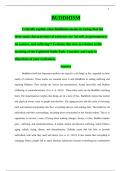1
BUDDHISM
Critically explain what Buddhism means in saying that the
three main characteristics of existence are ‘no self, no permanence/
no essence, and suffering’? Evaluate this view in relation to the
teaching of the Eightfold Noble Path. Consider and reply to
objections to your evaluation.
Answer
Buddhists hold that important qualities are typical to all things in life, regarded as three
marks of existence. These marks are essential since it aids Buddhists in ending suffering and
attaining Nibbana. They include the Anicca (no permanence), Anatta (non-self), and Dukkha
(suffering or unsatisfactoriness (Lee et al. 2018). These three seals are the Buddha's teaching
heart. The impermanence implies that things are in a state of flux. Buddhism claims that mental
and physical events come to people and dissolve. The aging process and the cycle of recurring
birth and Samsara encapsulate this flux; everything decays, and nothing lasts. This holds for all
individuals and their surroundings, including those reincarnated in the Naraka realms. This is in
opposition to nirvana, a state of being when nothing changes, decays, or dies. Dukkha implies
pain, suffering, and unsatisfactoriness. It entails mental and physical suffering, which follows
aging, rebirth, dying, illness, and dissatisfaction. Dukkha states that life fails to provide
individuals with what they need and desire (Lee et al., 2018). It also means that everything is
changing. Hence, people fail to attain absolute satisfaction because everything has confinement
, 2
(limitation), resulting in dissatisfaction. Anatta means no soul. This means no single sense of self
since all things are constantly changing. It also means that individuals lack souls. Annica means
impermanence. It implies that life's things are in constant transformation, and all are subject to
change. This paper will explore Buddhism's meaning in three main characteristics: suffering, no
essence/no permanence, and no self. This paper also evaluates these views in relation to the
teaching of the Eightfold Noble Path and provides objections sides while defending the paper's
position against these objections.
According to Buddhism, there are only three major characteristics of existence: suffering,
no essence/no permanence, and no self. Buddha taught that all things entailing experiences,
emotions, and thought are characterized by the Annica, Anatta, and Dukkha. These marks are
applicable to everything which is conditioned except the nirvana. Buddha asserts that
appreciating and understanding these marks of existence is of utmost importance in order to
realize enlightenment.
We recognize everything is prone to change and disintegration, as from the universe
amongst ourselves as well as our loved ones (impermanence). We recognize that each and every
compound object is susceptible to and would contribute to Dukkha (unhappiness/suffering).
Nothing we make can provide us enduring enjoyment due to our aversions and attachments
(Meshram et al., 2016). Finally, we recognize that there is nothing that we can fully identify as
"self." What we imagine and think of as self is actually not-self. There really is no inherent
everlasting identity/self in everything created. The "self" we consider ourselves is only the result
of the five aggregates (consciousness, mental formations, perception, feeling form), mechanisms
that emerge, and finally, decay. It is one of the schemas which is approved in Mahayana and
Theravada. However, they are highly emphasized mainly in the former. According to Buddha, all




